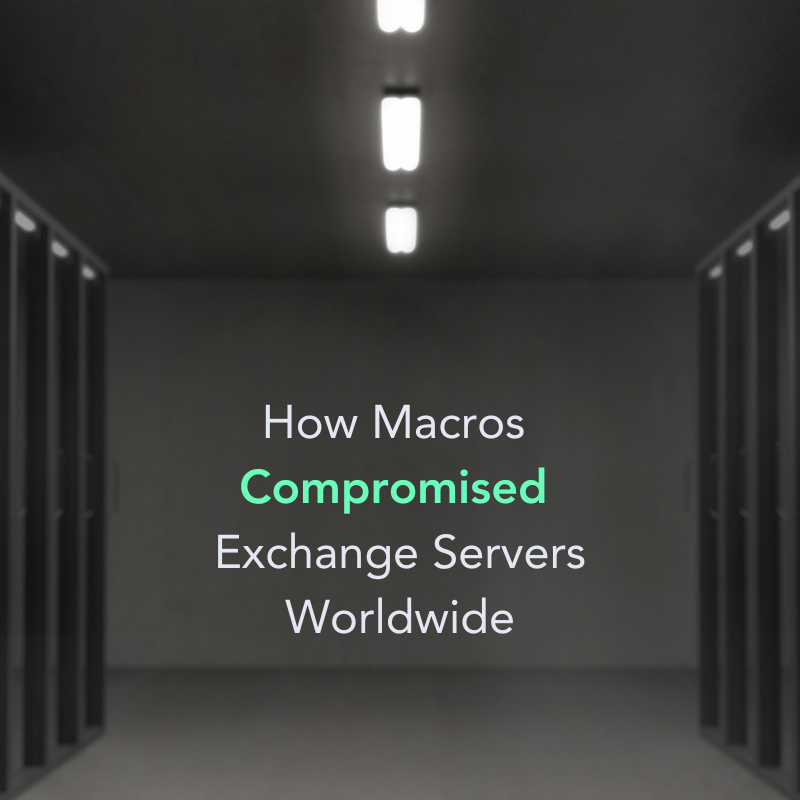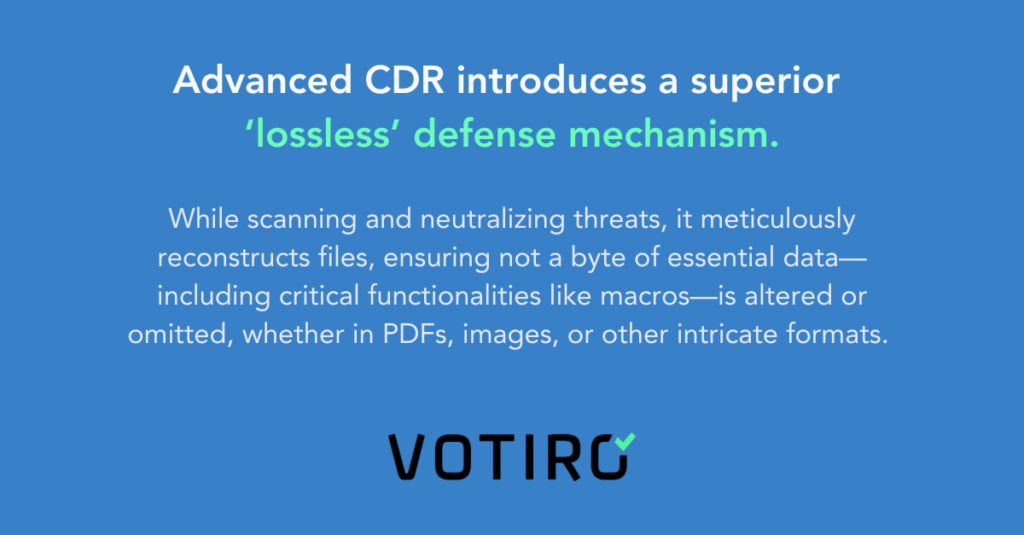How Macros Compromised Exchange Servers Worldwide

Few tools wield as much power and potential for harm as macros. While these are primarily known for their task-automation capabilities within software suites like Microsoft Office, their inherent ability to execute commands makes them ripe for exploitation by cybercriminals, which is why 87% of ransomware found on the Dark Web leverages macros to compromise devices. These threats are embedded discreetly within documents, waiting to download their nefarious payload from the internet post macro execution.
At the heart of this threat lies the dual-edged nature of macros. On one side, they’re tools designed for efficiency, seamlessly executing tasks that range from spreadsheet automation to document formatting. However, this ability to initiate commands makes them a target for malicious actors eager to install malware or gain remote access to systems.
Not too long ago, state-sponsored attackers from Russia utilized macros as a central component in their tactics to compromise exchange servers. In this article, we delve into the details of the onslaught and recommend measures organizations can adopt to safeguard themselves from becoming the ensuing target in the future.
The Macro Threat: What You Need to Know
Turla, often associated with state-sponsored cyber-espionage activities directed by Russia’s FSB, employed a sophisticated strategy to compromise systems and exfiltrate data. One of their recent attack vectors involves using Microsoft Excel macros.
The attack is initiated with phishing emails, which are deceptive emails masquerading as legitimate communications targeted toward individuals within an organization, especially those linked to the defense sector. These emails contained Excel attachments that, once opened, prompted the user to enable macros. These weren’t ordinary macros but maliciously crafted to run a PowerShell command upon activation. This PowerShell command’s primary role was to create a scheduled task that seemed benign, impersonating a Firefox browser updater.
However, this scheduled task was designed to download the ‘DeliveryCheck’ malware, aka CAPIBAR or GAMEDAY. Once activated, this malware would reside in the memory and connect to Turla’s command and control server. From there, it would receive further instructions, from downloading additional malware payloads to initiating the exfiltration of sensitive data. The nature of this attack means that it could bypass traditional antivirus solutions, especially since the malicious activity stemmed from a commonly trusted application: Excel.
How Bad Could It Be?
Exchange servers are pivotal to the daily operations of many organizations, serving as the nexus for internal and external communications, calendar scheduling, and data storage. These servers hold a treasure trove of sensitive data, from financial records and personal details to trade secrets. A breach could grant adversaries access to this information, opening the door to potential financial fraud and intellectual property theft. Moreover, malware introduced by the attacker can disrupt the regular flow of emails, hampering operations, derailing projects, and causing inefficiencies. Such disruptions impede organizational functions and damage reputations if the compromised server sends spam or malicious communications to partners, clients, or other stakeholders.
Beyond the immediate threats of data loss and communication breakdowns, a compromised Exchange server presents cascading challenges. The server can be harnessed as a tool to disseminate malware further, exacerbating the scope of the cyber attack. This risk, combined with the potential for stolen or deleted data, presents operational and financial difficulties, especially when considering data recovery costs or potential ransoms. Lastly, breaches can trigger significant regulatory and legal consequences, especially for regulated industry organizations. A lapse in data protection can culminate in hefty fines and potential legal proceedings, underscoring the vital importance of securing these servers.
For a business, the aftermath of a compromised Exchange server isn’t just about restoring the server to its normal state. It involves managing the fallout, including notifying affected parties, managing public relations, undertaking forensic investigations, and implementing measures to prevent future incidents. The total cost can be significant regarding direct financial impact and long-term trust and reputation damage.
CDR: Stopping Threats Before They Escalate
When stopping major threats hiding in macros, the best defense is a good offense. Content Disarm and Reconstruction (CDR) is a proactive approach to cybersecurity. At the core of CDR is its potent ability to neutralize hidden threats before they can breach systems. This cutting-edge technology safeguards pivotal gateways—like emails, web traffic, and cloud-stored data—commonly exploited by file-based malware. CDR establishes a formidable defense against most concealed file-borne threats by continuously overseeing and shielding these essential access points. This substantially diminishes the vulnerability of businesses to crippling ransomware attacks.
In today’s business landscape, data integrity and precision are vital. The tiniest oversight in security protocols can lead to considerable setbacks. To address this, advanced CDR solutions introduce a superior ‘lossless’ defense mechanism. While scanning and neutralizing threats, it meticulously reconstructs files, ensuring not a byte of essential data—including critical functionalities like macros—is altered or omitted, whether in PDFs, images, or other intricate formats. Advanced CDR upholds data purity and completeness and preserves intricate file functionalities such as macros and specific formatting. By integrating traditional AV assessments during its analysis phase, a comprehensive record of purged threats is formed, bolstering performance audits and establishing its efficacy in alignment with security norms.

Part of making effective cybersecurity is aligning seamlessly with existing tech infrastructures without causing interruptions. CDR has been crafted to cater to this very need. By integrating fluidly with prevailing systems, CDR ensures that protection is incessantly operative, securing critical data and communications without requiring extra steps or adjustments. Additionally, the ‘Zero Trust’ principle, where no data, file, or interaction is implicitly trusted, is inherent to CDR’s functionality. This proactive methodology ensures that threats are disarmed before they become problematic while CDR operates discreetly in the background. Consequently, businesses can run with the assurance that their data and systems are continuously protected without constant manual supervision.
Votiro Sanitizes Malicious Macros
Shield your organization from concealed dangers that can take down critical infrastructure using Votiro’s cutting-edge cybersecurity tools. With our CDR technology, preserve the sanctity of your crucial documents and files by eradicating hidden malware and vulnerabilities, all while upholding content authenticity. Votiro empowers you to counter document-centric attacks, file-related risks, and even emergent zero-day threats by proficiently reconstructing files, ensuring all pivotal functionalities remain untouched.
Don’t let your organization be exposed to covert dangers. Act preemptively and collaborate with Votiro to strengthen your operations against cyber threats, safeguarding your prized assets without burdening your staff with additional security hurdles.
Contact us today to learn more about Votiro, which sets the bar for preventing hidden threats in files to keep your organization secure while maintaining productivity.
News you can use
Stay up-to-date on the latest industry news and get all the insights you need to navigate the cybersecurity world like a pro. It's as easy as using that form to the right. No catch. Just click, fill, subscribe, and sit back as the information comes to you.
Sign-up Here!
Subscribe to our newsletter for real-time insights about the cybersecurity industry.



